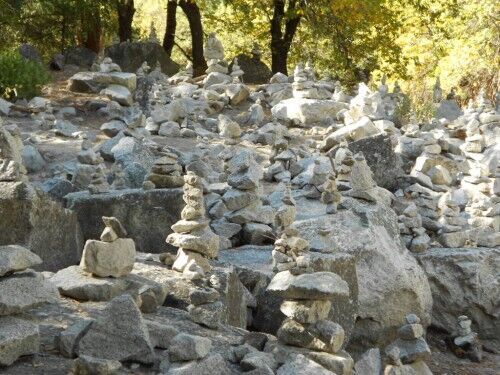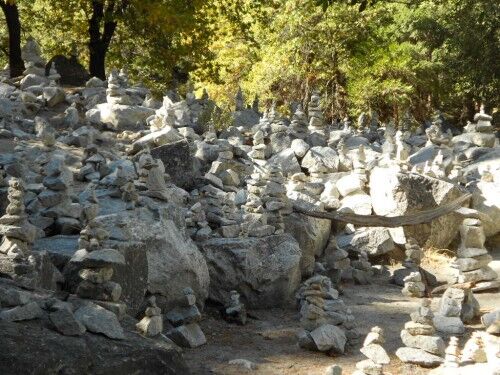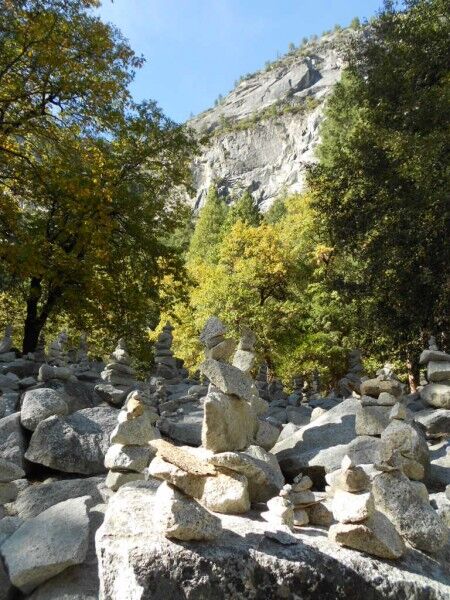I wrote recently about people feeling free to scratch their names into the salt beds at Badwater in Death Valley National Park and whether we should be ambivalent toward this “temporary” graffiti. Even if nature can eventually erase it, doesn’t it just encourage others to mark more areas of our national parks with their names where it’s not nearly as easy for nature to remove the graffiti?
Here is another one of those questions that I recently began to wonder about with a recent trip to Yosemite National Park. Just beyond Mirror Lake to the left is a large area that has been completely taken over by rock stacking. There are literally thousands of rocks which have been stacked and balanced by people completely transforming this are from its natural state:

The first reaction from most of the people who stumbled across it was the thought it might be a cemetery of some type, but it quickly becomes apparent that people simply decided to begin stacking rocks and continue to do so. While many would not consider this being nearly as disruptive as people scratching their name into sandstone or spray painting their name on walls, isn’t rock stacking nothing more than another way of leaving a type of graffiti in our national parks by moving nature into unnatural arrangements? Just because it looks better than a name written on a rock, does that make it OK to do?
What do you think? Is rock stacking fundamentally different from other types of graffiti and therefore OK, or is it something that should be discouraged just as much as what we would consider typical graffiti?



I wouldn’t call it graffiti. Vandalism is a better word for it. And there’s no place for it inside any national park.
I’m against vandalism, of course; everybody is. But is this really vandalism?
In one of his novels, The Lonesome Gods, Louis L’Amour has the protagonist saying that indians had, for centuries, been leaving stacks of rocks along trails as a sign of respect to the gods. Many people, not knowing any better, would tear into the stones, expecting to find some sort of treasure, but there was nothing there. He explains that he always tosses another stone on the pile, himself, out of respect for the gods. How old are those stone piles, anyhow? If they’ve been growing for a few millenia, would that matter?
But they obviously aren’t carefully balanced if he tosses a stone on top..
There is an tendency to view a dam as natural and wonderful if built by beavers and terrible, a blight upon the land, if built by men. A developer who wants to build hundreds of cabins on the mountainside is an evil man, so say the nature lovers who built their cabin two years ago. It’s a shame when people hate themselves and their species so much that people don’t get the same respect granted to other speciesIn one of his novels, The Lonesome Gods, Louis L’Amour has the protagonist saying that indians had, for centuries, been leaving stacks of rocks along trails as a sign of respect to the gods. Many people, not knowing any better, would tear into the stones, expecting to find some sort of treasure, but there was nothing there. He explains that he always tosses another stone on the pile, himself. It’s a shame when people hate themselves and their species so much that people don’t get the same respect granted to other species
Reminds me of the old joke:
“What’s the difference between an environmentalist and a developer?”
“An environmentalist ALREADY has a house in the woods.”
Rock stacking is most definitely vandalism. Our national parks have been set aside by Congress to preserve the landscape as it was, is and (hopefully) always will be… natural. Rock stacks are anything but natural. They are a blight on the landscape and do not belong on our national parks.
As John Muir said: “As long as I live, I’ll hear waterfalls and birds and winds sing. I’ll interpret the rocks, learn the language of flood, storm, and the avalanche. I’ll acquaint myself with the glaciers and wild gardens, and get as near the heart of the world as I can.”
I see nothing in there about stacking rocks.
I really wish people would stop this ridiculousness. National Parks are not ours to deface and destroy. If ‘stackers’ do not have the capacity to appreciate natural beauty for what it is, the least they can do is leave it be for those of us that do.
If rocks were stacked in different places all over the park, it would be a widespread issue. But the rock towers are confined to a small area towards the side of the trail. No big deal right?
This is human nature doing it’s thing…shaping our world. Is it really that unnatural?
Really???? All that is wrong with the world and we are worried about a few rocks being stacked.
It’s vandalism via ignorance. People go to these places of beauty, and see some piles of rocks left by others. They’re inspired to leave their own evidence of being. Some are truly skillfully balanced. Most are just stacked like kids’ building blocks. Unfortunately none of these kids learned to put their toys away and nature’s order is now human disorder. These YOPS are just another form of graffiti, “I was here,” intruding on the next person’s experience of what used to be nature’s vistas. I know, with all that’s wrong in the world, this seems a silly concern, but it’s precisely because of all that’s wrong in the world that we need to preserve the few pockets of nature that remain, allowing wind and sun and gravity to sort things out. Folks that turn to nature, go to refresh their souls. We don’t go to populated urban areas for that, and we don’t want to see your building block structures, reminding us of the hordes of people who have passed by already. Please, build your little cairns, take your picture & tweet or post or whatever, but then knock it down, scatter the rocks and move on.
Walked up to Mirror Lake and found Mirror Meadow. It was a surprise, and somewhat of a disappointment not to see the Lake but it was Nature at work. Meandering back on the trail of the dry river bank, we glanced over to see meticulously arranged stacks of rocks of all sizes on the stone steps leading off to another trail. We were amazed and in awe of the hundreds of carefully balanced stones. Some encorporated sticks and twigs. Most did not. We didn’t know what to think. Our first thought was that an artist had gotten permission to make a statement using these universal markers that appear across many cultures and time periods. When hiking the Langtang Mountain Trail in Nepal we found a number of stacks of rocks very similar to these placed along the way by Buddhists on the way to the Monastery at the top of the trail. We we enthrall end and delighted by these stone piles and looked forward to learning more about the mystery. There were other hikers who were also enjoying and photographing the stones while we were visiting them. For all of you who are objecting to this ephemeral art work. Don’t worry.
After winter they will be gone. For all who don’t want to miss this delightful sight, hurry up to Mirror Lake.
Every time a human steps foot in a national park they are marking it up with human tracks. Yes, this sounds extreme, but so are these idiots that think rock staking is vandalism or Graffiti. The very act of a human stepping foot in a national park is vandalism, you are killing a bug, moving a rock out of place, breaking a branch, crushing grass and so on.
Get a life you freaks, you have noting better to do? My son was yelled at today from doing a finger painting today, in water color paint I might add, that washes off. He was yelled at by some stick think hippie rock climber. As she pounded her rock climbing anchor spike into the rocks, defacing the rock, she continued to yell and be nasty to my son. I was teaching my son the art ancient rock painting from his ancestors. We are Hopi! This women was actually on Hopi land and yelling at us!
You people are insane losers! Get a life!
Talasi
I agree with the last two comments. It is a form of temporary artwork. People who are so worried about this petty stuff are the same ones who bullied their way through school.